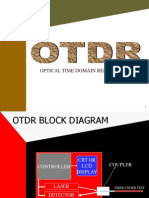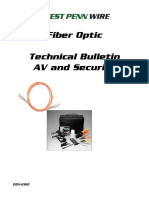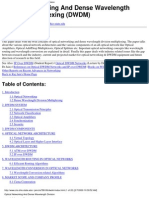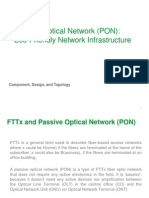Understanding FiberOptics
Uploaded by
InformaticaTempleUnderstanding FiberOptics
Uploaded by
InformaticaTemple30149215.000.1007.understandingfo.po.fop.tm.ae.
qxd
10/12/07
8:52 AM
Pla
sti
Page 1
Understanding Fiber Optics
cc
oa
ti
ng
Cla
dd
ing
Optical Fiber Types
ypes
Optical Fiber Types
iber Types
Main type
Singlemode
8m
- Low attenuation
to
12m
- 1260 to 1640 nm transmission wavelengths
- Access/medium/long haul networks (>200km)
- Nearly infinite bandwidth
50m
62.5m
- High attenuation
Multimode
(graded index) - 850 to 1300 nm transmission wavelengths
- Local networks (<2 km)
- Limited bandwidth
125m
re
Visible light
Index
Profile
propagation
Lightwave propag
Typical dimensions
Characteristics
Fiber
Optic
Transmission
Fiber Optic
Transmission
Windows
Co
250 to
900m
Transmission
Transmiss
Windows
Win
700
1100
1200
850
1300
1400
1300 /1310 1383
1st Window
Water peaks
1500
1600
Connector types*
Name
1490 1550 1625
2nd/3rd Window
NSWP Single mode Fiber
Applications
Characteristics of a 50/125 mm
multimode graded index
optical fibre cable.
Video and Datacom in premises networks.
Up to 10 GigE transmission in local area networks (up to 300 m).
Wavelength coverage: 850 to 1300 nm
G.652 Class A/B
G.652 Class C/D
Characteristics of singlemode
optical fiber and cable
From access to long haul networks. Supports high bit rate
transmission (10 Gb/s and +, 10 GigE). Suitable for DWDM and CWDM systems.
Wavelength coverage: 1260 to 1625 nm.
G.655 Class C
G.655 Class D
G.655 Class E
Characteristics of non-zero
dispersion shifted singlemode
optical fiber and cable.
Transmission applications at high bit rates for STM-64/OC-192 (10 Gb/s) over longer
distances. Suitable for STM-256/OC-568 (40 Gb/s). Supports DWDM transmission
applications in the C+L bands.
Wavelength coverage: 1550 to 1625 nm.
G.657 Class A
G.657 Class B
Characteristics of bending loss
insensitive singlemode optical fiber
and cable for the access network.
Support optimized access network installation with very short bending radii applied
in fiber management systems and particularly for in- and outdoor installation,
specialy in FTTx network.
Wavelength coverage: 1260 to 1625 nm.
G.651
1000
10
Refractive index: A measure of the speed of light in a material. n1 and n2 are the respective refractive index of the cladding and the core.
n1<n2 is the condition for the light to travel down the fiber.
Index profile: Variations of the refractive index along a fiber diameter.
Description
900
Applications
FC-PC / FC-APC
Datacom,
Telecommunication,
CATV
SC-PC / SC-APC
Datacom,
Telecommunication,
CATV, LAN
E2000-PC / E2000-APC
(Ferrule diameter : 1.25mm)
Telecommunication,
Datacom, CATV, LAN
LC-PC / LC-APC
(Ferrule diameter : 1.25mm)
High density interconnection,
Datacom,
telecommunication, CATV
ST-PC
Inter-/Intra-building,
Security, Navy, Datacom,
LAN
MU-PC / MU-APC
Datacom,
Telecommunication,
CATV
MT-RJ (Ribbon fiber)
Tatacom,
LAN
Biconic
LAN, Datacom, Medical
instrumentation, Remote,
sensing, Telemetry, CATV
DIN-PC / DIN-APC
Datacom,
Telecommunication,
CATV
Attenuation (dB/km)
n2 1.540
to 1.562
ITU Fiber Standard
Wavelength (nm)
800
635
n1 1.540
250 to
900m
Fiber transmission wavelength range
(IR - Infrared)
Windows
n1 1.457
n2 1.471
125m
Optical
Connectors
Optical Connector
nnector
S C L U
LWP Single mode Fiber
1
Rayleigh scattering
IR absorption
0.1
Wavelength (nm)
800
Water-proof tape
Possible fillers
oor)
(outd
les
b
ca
Outer jacket
Aramid yarn
tu
Overall polyester barrier
be
Outer jacket
Flooded core
Thermoplastic
jacket
Thermoplastic
jacket
Aramid
strength element
Bloisture
blocking gel
Central member
FRP strength member
900 microns tight buffered fibers
Multiple 250 microns fibers
Rib
bon
fiber cables
Outer jacket
Dielectric strength
members
Band
Description
Wavelength Range
Original (2nd Window)
1260 to 1360 nm
Extended
1360 to 1460 nm
Short Wavelengths
1460 to 1530 nm
Conventional ("erbium window")
1530 to 1565 nm
Long wavelenghts
1565 to 1625 nm
Ultralong wavelengths
1625 to 1675 nm
Buffer tube
Ribbon
Applications: Computer rooms, telecommunications
central offices, tunnel and confined areas, riser shafts.
Applications: Building interconnections, telecommunications
and, data trunk, long haul networks, ducts between buildings.
Typical applications: equipment interconnect,
high speed data transfer, premise network
Tight buffered tube cable can hold from 1 to 12 fibers
per tube (up to 200 fibers in one cable).
Applications requiring moisture and weather resistant. Loose
tube cable can hold from 1 to 12 fibers per tube (up to 200 fibers
in one cable).
Ribbon cables can hold 204 fibers in a 0.5-inch cable.
This picture shows a 3000 fiber underground cable.
Optical
Transmission
Optical Transmission
tical Transmission
1400
1600
LED and Laser diode power spectra
-15 to -25 dBm
FWHM
100 nm
0 to -10 dBm
+5 to -10 dBm
FWHM
3 nm
<<1 nm
When installing a fiber network, network topology and equipment
specifications must be considered. One of the major parameters requiring
measurement is optical loss budget, or end-to-end optical link loss.
When calculating the optical loss budget of a fiber link, the source,
detector, and optical transmission line must be considered.
Optical loss budget should take into account both link loss and system
power margins. These power margins cover allowances for the effects
Splice loss
of environment, aging and eventual repairs.
In order to calculate link loss budgets, typical values of the different
component are used.
Splice gain
An example of a typical singlemode system could be:
(1)
Average Transmitter (Tx) output optical power: 0 dBm
(2)
Minimum Receiver (Rx) sensitivity:
-20 dBm
(1) (2) Maximum optical loss budget:
20 dB
A Total connector Loss = 0.5 dB x Number of connector pairs
1300
LED
1300
FP laser diode
(MLM laser)
The type of fiber used and the characteristics of the source impose limits on system
performance. The narrower the spectral bandwidth of the source diode, the higher
the possible frequency bandwidth/bit rate of the system.
- LED: Short-haul and law bitrate (LAN networks) systems that use multi-mode fibers.
- Laser diode: Long-haul and high bitrate systems that use single mode fibers.
Multi-Longitudinal Mode (MLM) lasers, also known as Fabry-Perot (FP) lasers and Single
Longitudinal Mode (SLM) or Distributed Feedback (DFB) lasers are used for these applications.
Photodetectors spectral response
S y (A/W)
InGaAs
1.0
Network
(Link Loss)
y (nm)
1300
DFB laser diode
(SLM laser)
B Total fiber Loss = loss per km x fiber distance
1310 nm 0.35 dB/km
1550 nm 0.2 dB/km
Rx
D Total other components loss = loss x Number of components
Mechanical splice 0.5 dB
1:2 splitter
3.5 dB
1:32 splitter
17 dB
Ge (23C)
Si
C Total splice Loss= 0,1 dB x Number of splices
Ge (0C)
0.5
850
1300
1550
Si: Silicon, applications in the visible light range (400 to 1000 nm)
Ge: Germanium, applications in optical windows (750 to 1600 nm)
InGaAs: Induim Galium Arsenide, application in optical windows (>1000 nm)
Attenuation is the result of a variety of scattering and absorption mechanisms, and is
wavelength dependent.
Since singlemode optical fibers are designed to operate over a wide range of wavelengths,
the attenuation measurement is performed as a function of wavelength, typically between
1200 nm and 1625 nm.
Fiber optic transmission makes use of the three optical windows (850,1300, 1550 nm) that
are given by the attenuation characteristics of the silica fibers.
Also, 635 nm light is used for visible fault location.
For remote fiber testing a wavelength of 1625nm or above is used to not disturb the traffic.
* Non exhaustive list
Before cleaning
After cleaning
Optical Connection Inspection
Rayleigh scattering: light energy is scattered in all directions causing loss.
NSWP: Non Suppressed Water Peak.
LWP: Low Water Peak (ex: G.652.D fiber).
Optical Loss Budget
Tx
1200
A cable is an assembly of optical fibers with materials providing mechanical and environmental protection of the optical fibers
Loos
e
d
re
les (Indoo
e ca b
r)
tub
Tigh
tb
uf
fe
Typical fiber cables
1000
It is very important to clean connectors.
A dirty connector will dramatically increase the power loss !
Inspect your connector before and after cleaning using a videoscope.
Physical Contact (PC) Connector
Measurement units : Watts, dB or dBm
Angled Physical Contact (APC) Connector
8
Absolute Power (mW)
Absolute Power (dBm)
1000
100
10
5
1
0,5
0,1
0,01
0,001
0,0001
+30
+20
+10
+7
0
-3
-10
-20
-30
-40
Loss (dB)
Power (%)
- 0,10
- 0,20
- 0,35
-1
-3
-6
- 10
- 20
2
5
8
20
50
75
90
99
Insertion Loss: 0 to 0.5 dB
Optical Return Loss: >40 dB
Insertion Loss: 0 to 0.5 dB
Optical Return Loss: >60 dB
Insertion Loss (IL): Loss in transmitted signal power resulting from the insertion of a component in an optical fiber link.
Optical Return Loss (ORL): Ratio of the reflected power to the incident power from a fiber optic link or system,
expressed as a positive value.
Connector Mating
Plug pair
Plug pair
Hybrid mating adapter
Key
Mating adapter
Ferrule
Key
y (nm)
dB: quantify gain or loss
P1
dB = 10 log
(P1 and P2 expressed in Watts)
P2
dBm: specify absolute power levels
P1
P(dBm) = 10 log
(P1 expressed in mW)
1mW
Understanding Fiber Optics
To learn more, visit www.jdsu.com/fibertest
Note: Specifications, terms, and conditions are subject to change without notice.
30149215 000 1007 UNDERSTANDINGFO.PO.FOP.TM.AE
4338_Poster 1-3.indd 3
10/16/07 3:34:56 PM
You might also like
- Hourglass Workout Program by Luisagiuliet 276% (21)Hourglass Workout Program by Luisagiuliet 251 pages
- The Hold Me Tight Workbook - Dr. Sue Johnson100% (16)The Hold Me Tight Workbook - Dr. Sue Johnson187 pages
- Read People Like A Book by Patrick King-Edited62% (65)Read People Like A Book by Patrick King-Edited12 pages
- Livingood, Blake - Livingood Daily Your 21-Day Guide To Experience Real Health77% (13)Livingood, Blake - Livingood Daily Your 21-Day Guide To Experience Real Health260 pages
- COSMIC CONSCIOUSNESS OF HUMANITY - PROBLEMS OF NEW COSMOGONY (V.P.Kaznacheev,. Л. V. Trofimov.)94% (212)COSMIC CONSCIOUSNESS OF HUMANITY - PROBLEMS OF NEW COSMOGONY (V.P.Kaznacheev,. Л. V. Trofimov.)212 pages
- Donald Trump & Jeffrey Epstein Rape Lawsuit and Affidavits83% (1016)Donald Trump & Jeffrey Epstein Rape Lawsuit and Affidavits13 pages
- Useful Not True - Derek Sivers - 2024 - Anna's ArchiveNo ratings yetUseful Not True - Derek Sivers - 2024 - Anna's Archive138 pages
- The 36 Questions That Lead To Love - The New York Times94% (34)The 36 Questions That Lead To Love - The New York Times3 pages
- The 36 Questions That Lead To Love - The New York Times95% (21)The 36 Questions That Lead To Love - The New York Times3 pages
- Jeffrey Epstein39s Little Black Book Unredacted PDF75% (12)Jeffrey Epstein39s Little Black Book Unredacted PDF95 pages
- The 4 Hour Workweek, Expanded and Updated by Timothy Ferriss - Excerpt23% (954)The 4 Hour Workweek, Expanded and Updated by Timothy Ferriss - Excerpt38 pages
- Topic: Fiber Optic Network Design: Table of Contents: The FOA Reference Guide To Fiber Optics100% (1)Topic: Fiber Optic Network Design: Table of Contents: The FOA Reference Guide To Fiber Optics25 pages
- The Difference Between DWDM and OTN: DefinitionNo ratings yetThe Difference Between DWDM and OTN: Definition4 pages
- DWDM Troubleshooting (Compatibility Mode)No ratings yetDWDM Troubleshooting (Compatibility Mode)24 pages
- Topic: Accurately Testing Fiber Optic Cables: Table of Contents: The FOA Reference Guide To Fiber OpticsNo ratings yetTopic: Accurately Testing Fiber Optic Cables: Table of Contents: The FOA Reference Guide To Fiber Optics11 pages
- JDSU Fibercharacterization Poster October2005No ratings yetJDSU Fibercharacterization Poster October20051 page
- Coarse Wavelength Division Multiplexing (CWDM)No ratings yetCoarse Wavelength Division Multiplexing (CWDM)15 pages
- DWDM Impairments Optical Transport Networks (OTN) : Linear Effects100% (1)DWDM Impairments Optical Transport Networks (OTN) : Linear Effects1 page
- Fiber Testing and OTDR Basics: Brett Isley Terriitory Sales ManagerNo ratings yetFiber Testing and OTDR Basics: Brett Isley Terriitory Sales Manager54 pages
- Optical Channel (Och) /optical Transmission Unit (Otu) Otn LayersNo ratings yetOptical Channel (Och) /optical Transmission Unit (Otu) Otn Layers1 page
- Telecomunications Cabling Specification v5100% (1)Telecomunications Cabling Specification v577 pages
- Passive Optical Network (PON) : Eco-Friendly Network InfrastructureNo ratings yetPassive Optical Network (PON) : Eco-Friendly Network Infrastructure53 pages
- EXFO Reference-Poster FTTx-PON-Testing en PDFNo ratings yetEXFO Reference-Poster FTTx-PON-Testing en PDF3 pages
- IECEP Cagayan Valley - Structured CablingNo ratings yetIECEP Cagayan Valley - Structured Cabling46 pages
- Microwave Filters for Communication Systems: Fundamentals, Design, and ApplicationsFrom EverandMicrowave Filters for Communication Systems: Fundamentals, Design, and ApplicationsNo ratings yet
- Peter M. Mcisaac Museums of The Mind German Modernity and The Dynamics of Collecting 2007No ratings yetPeter M. Mcisaac Museums of The Mind German Modernity and The Dynamics of Collecting 2007338 pages
- Test Bank Management System Applying Rasch Model and Data Encryption Standard (DES) AlgorithmNo ratings yetTest Bank Management System Applying Rasch Model and Data Encryption Standard (DES) Algorithm9 pages
- SMAS: The Superficial Musculoaponeurotic System Is A Fibromuscular Fascial ExtensionNo ratings yetSMAS: The Superficial Musculoaponeurotic System Is A Fibromuscular Fascial Extension4 pages
- Austin Journal of Nutrition & MetabolismNo ratings yetAustin Journal of Nutrition & Metabolism12 pages
- An Emphasis On Planning - The Calculating Era (1950 - 1970) UpdatedNo ratings yetAn Emphasis On Planning - The Calculating Era (1950 - 1970) Updated23 pages
- Shri Krishna Govt. Ayurvedic College, Kurukshetra: Umri Road, Sector-8, Kurukshetra, Haryana-136118No ratings yetShri Krishna Govt. Ayurvedic College, Kurukshetra: Umri Road, Sector-8, Kurukshetra, Haryana-1361181 page
- Functions and Anatomy of Human Body GK Notes in PDFNo ratings yetFunctions and Anatomy of Human Body GK Notes in PDF14 pages
- Chapter 16: Sales Promotion and Personal SellingNo ratings yetChapter 16: Sales Promotion and Personal Selling40 pages























































































































